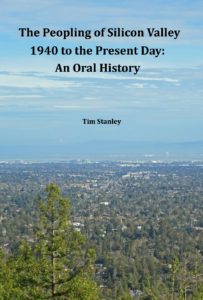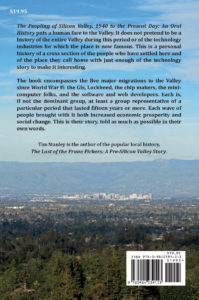 The Peopling of Silicon Valley, 1940 to the Present Day: An Oral History puts a human face on the Valley. It does not pretend to be a history of the entire Valley during this period or of the technology industries for which the place is now famous. This is a personal history of a cross section of the people who have settled here and of the place they call home with just enough of the technology story to make it interesting.
The Peopling of Silicon Valley, 1940 to the Present Day: An Oral History puts a human face on the Valley. It does not pretend to be a history of the entire Valley during this period or of the technology industries for which the place is now famous. This is a personal history of a cross section of the people who have settled here and of the place they call home with just enough of the technology story to make it interesting.
The book is a compilation of more than 180 stories, or personal accounts, of people who live here, have lived here, or are otherwise connected to the Valley. Some stories are only a few lines; others require a few pages. Many of these stories are as interesting as any I have ever read, and they open up the history of the Valley in a way it cannot be known otherwise.
If you ask five people where Silicon Valley is, you may get five different answers. Old-timers will tell you the Santa Clara Valley became Silicon Valley. Older technical people may tell you it’s San Jose and the southern San Francisco peninsula. Younger techies, who live in Fremont, San Mateo, or other places around the San Francisco Bay, and like to say they are from Silicon Valley, often assert that it encompasses the entire Bay Area. For brevity, some just say, “San Jose.” Others get philosophical about it and say something like, “It’s where the technology is happening.” Since I was here long before the term was used, I will stick with the first definition—Santa Clara Valley. But in fact the term “Silicon Valley” has been a misnomer for decades because the silicon fabrication plants, though once numerous, are now about as rare around here as prune orchards are. Both are from bygone eras.
Most of the history of the Valley is not spectacular; it is of ordinary people doing ordinary things in the midst of what became an extraordinary place. The stories in this book, by being candidly told, give voice to the human experience in the midst of what has often been an out-of-control environment.
The book encompasses the five major migrations to the Valley since World War II: the GIs, Lockheed, the chip makers, the minicomputer folks, and the software and web developers. Each is, if not the dominant group, at least a group representative of a particular period that lasted fifteen years or more. Each wave of people brought with it both increased economic prosperity and social change. This is their story, told as much as possible in their own words. I have used narrative sparingly to provide adequate historical context.
If you are frustrated by books that repeat well-known information without telling you what is crucial—that is, the why and how of events—you will enjoy this one. For example: A dozen books may tell you that the blimps stationed at Moffett Field Naval Air Station used helium for lift without telling you the fascinating story of that helium. Likewise, an equal number of books tell of the rapid development of the Santa Clara Valley after World War II but fail to say why that development did not begin in earnest until 1950. And so it is, too, with many matters fundamental to the discussion of semiconductors, integrated circuits, programming languages, and search engines. As with The Last of the Prune Pickers: A Pre-Silicon Valley Story and all my books, this book is meant to educate, not merely to entertain. 
Throughout the book I have respected the saying, “You do not really understand something unless you can explain it to your grandmother.” This saying has been attributed to Albert Einstein. Whether he said it or not, I don’t know; but I do agree with the statement, and for that reason I present technical matters in a way that is easy to understand.
In a history book, if the author leaves out everything that might be regarded as sensitive, you end up with what I call a mayonnaise sandwich. It has little or no value, is so sanitized that it has no substance, and the facts of history have been withheld or, worse yet, distorted. For this reason, I have included many stories from people who prefer to remain anonymous. For the most part, these occur in the later chapters and are from individuals who were very candid in private conversation but did not want their identity disclosed. In a few cases, I have changed some insignificant details of someone’s story to further protect their anonymity.
Some of the stories were told to me by people I did not know, or I have forgotten who they were. These are credited as “Unknown.”
I have also included some of my own stories where I thought they would be helpful in rounding out a chapter. These begin with my initials, T.S.
Additionally, to fill what I perceived to be gaps in the book, I included about a dozen stories from people who have not lived in the Valley but in other parts of the San Francisco Bay Area, elsewhere in California, or in other technology centers.
Last, we all see things from different perspectives, our own perspective can change over time, and memories are not always accurate. For this reason I researched many of the claims found in the oral histories and have done my best to see to it that historical facts are presented as fairly and accurately as possible.
So come along with me and take a look at the human side of the Valley, past and present.